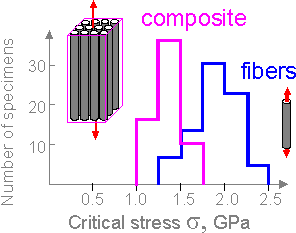 A specific feature of composites is high scatter in strength of strong fibers. Composites usually have lower average strength and scatter in comparison to fibers.
A specific feature of composites is high scatter in strength of strong fibers. Composites usually have lower average strength and scatter in comparison to fibers.
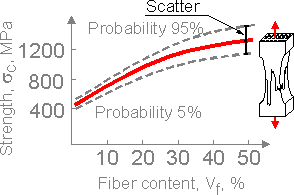 For constant average strength and higher scatter there is a higher probability that microcracks in the weakest fibers are surrounded by strong fibers. Strength of such composites is usually high.
For constant average strength and higher scatter there is a higher probability that microcracks in the weakest fibers are surrounded by strong fibers. Strength of such composites is usually high.
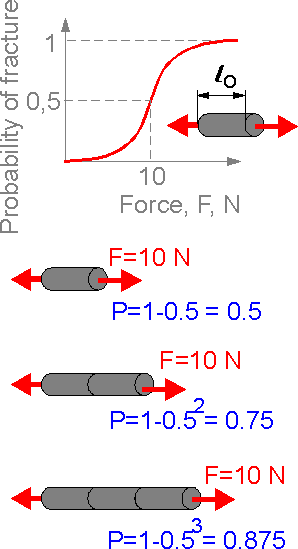 Higher average strengths correspond to higher scatter in experimental data. This rule is valid for fibers and composite materials.
Higher average strengths correspond to higher scatter in experimental data. This rule is valid for fibers and composite materials.
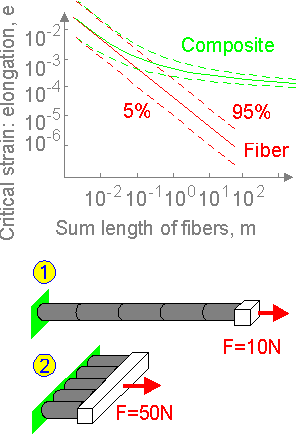 If probability of fracture of a fiber with length lo is 0.5, then probability of failure of a longer fiber is higher. Fibers with longer length have lower strength. Composite series-parallel structures do not decrease the strength to zero due to strength redundancy of parallel elements.
If probability of fracture of a fiber with length lo is 0.5, then probability of failure of a longer fiber is higher. Fibers with longer length have lower strength. Composite series-parallel structures do not decrease the strength to zero due to strength redundancy of parallel elements.
Probability of failure of a series structure composed of similar elements (fibers) is higher than that for a parallel structure:
P1 > P2.
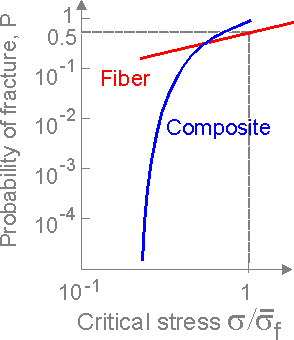 The average strength of a composite is less than the average strength of its fiber. At low stress, the probability of fracture of a composite (series-parallel system) is lower than for fibers.
The average strength of a composite is less than the average strength of its fiber. At low stress, the probability of fracture of a composite (series-parallel system) is lower than for fibers.
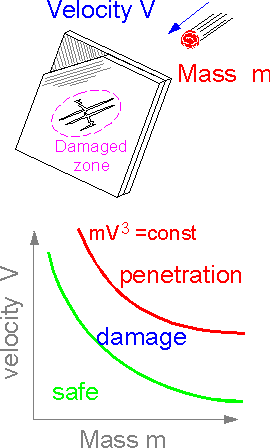 Experimental data shows that the condition of penetration of a flying body depends on its mass and velocity. The damage decreases fatigue strength of the laminate.
Experimental data shows that the condition of penetration of a flying body depends on its mass and velocity. The damage decreases fatigue strength of the laminate.
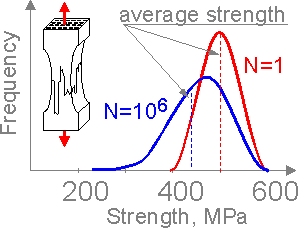 Cyclic loading (fatigue microdamage) decreases the remaining static strength of a composite structure.
Cyclic loading (fatigue microdamage) decreases the remaining static strength of a composite structure.
JOINTS
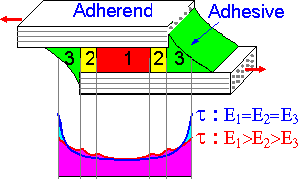 There is high stress concentration in the lap joint. It can be decreased if the Young's modulus of the adhesive decreases at the edges.
There is high stress concentration in the lap joint. It can be decreased if the Young's modulus of the adhesive decreases at the edges.
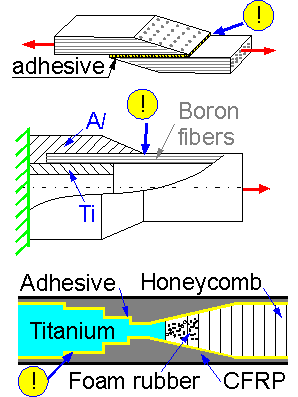 Stress concentration is smaller for a В«smoothВ» transition from one structural element (adherent) to another.
Stress concentration is smaller for a В«smoothВ» transition from one structural element (adherent) to another.
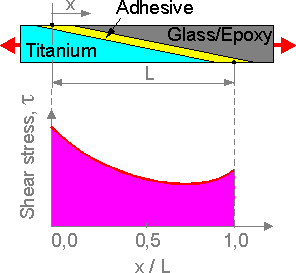 Stress concentration is higher at a more rigid material. Proper laminar orientation can decrease the stress concentration.
Stress concentration is higher at a more rigid material. Proper laminar orientation can decrease the stress concentration.
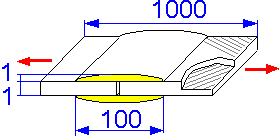 The joint's bond surface must be sufficiently larger than it's cross-sectional area. The joint can be reinforced by fabric fibers.
The joint's bond surface must be sufficiently larger than it's cross-sectional area. The joint can be reinforced by fabric fibers.
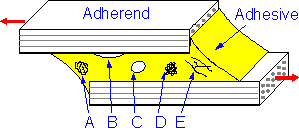 Manufacturing defects in the adhesive can decrease strength of joints and can be detected by nondestructive testing. The following are examples of some defects:
Manufacturing defects in the adhesive can decrease strength of joints and can be detected by nondestructive testing. The following are examples of some defects:
A. Matrix cure is caused by incorrect mixing or thermal exposure.
B. Disbond or zero-volume unbond is caused by incorrect surface preparation.
C. Voids can be caused by air entrapment.
D. Porosity is associated with volatiles and entrained gases.
E. Adhesive cracks can be caused by thermal shrinkage during manufacturing.
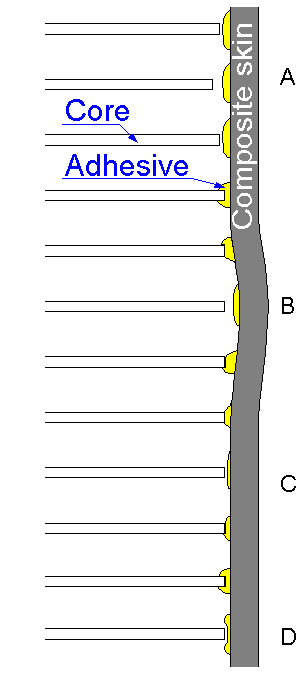 Composite honeycomb structures have high flexural stiffness and strength. Defects decrease flexural and compressive strength of honeycomb structures:
Composite honeycomb structures have high flexural stiffness and strength. Defects decrease flexural and compressive strength of honeycomb structures:
A. Core damage.
B. Skin imperfection.
C. Lack of adhesive.
D. Improperly formed adhesive fillet.
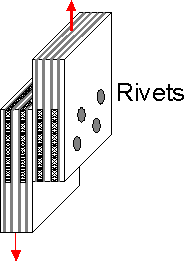 Rivets are widely used in composite skin connection. Strength of rivet joints can be increased by increasing the number of smaller rivets and/or by metal foil reinforcement.
Rivets are widely used in composite skin connection. Strength of rivet joints can be increased by increasing the number of smaller rivets and/or by metal foil reinforcement.
 Connection of the composite tubes can be made by elastic deformation in the composites. Filament winding increases the carrying ability of the joint.
Connection of the composite tubes can be made by elastic deformation in the composites. Filament winding increases the carrying ability of the joint.
 2015-08-13
2015-08-13 362
362








